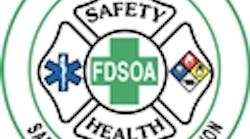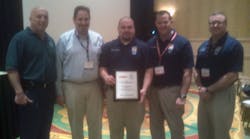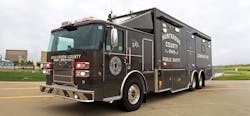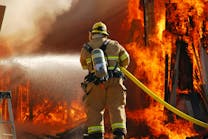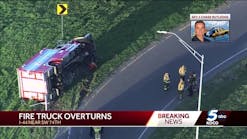ORLANDO – Proper and continuous training on apparatus operations is essential to safety for motorists and firefighters alike and to achieve that goal, a new program has been developed with the help of the Fire Apparatus Manufacturers Association (FAMA).
Roger Lackore, director of product safety for Oshkosh Corp., the parent company of fire truck builder Pierce Manufacturing, presented a lecture titled “Apparatus Training & FAMA Safety Guide (NFPA 1451),” at the annual Fire Department Safety Officers Association apparatus symposium in Orlando on Tuesday.
“You’re in a dangerous job to begin with,” Lackore said. “You need an apparatus safety program. It is so important for you as a firefighter and for your department.”
Lackore presented a practical and systematic way of developing apparatus safety training for fire departments nationwide and it begins with a collection of all printed materials and resources for a reference library.
The library, which should be accessible to all firefighters, should have all the operators’ manuals from the manufacturers, including all the component manuals and, manual from the cab and chassis manufacturers if the apparatus is built on a commercial cab and chassis.
He added the library should include state motor vehicle laws that apply to drivers as well as national Commercial Drivers’ License (CDL) laws.
The National Fire Protection Association (NFPA) also has several books outlining standards for safe operation of apparatus and Lackore recommended departments get them, particularly NFPA 1451, “Standard for a Fire and Emergency Services Vehicle Operations Training Program.”
The International Association of Fire Chiefs (IAFC), the Volunteer Firemen's Insurance Services (VFIS), and the International Fire Service Training Association (IFSTA) all have great vehicle training material available for fire departments, Lackore said.
Offering an opinion, Lackore said firefighters who drive fire apparatus, ought to have CDLs. He acknowledged that many states have exemptions to that rule, but he disagrees with them.
“If you are going to drive a fire truck on the road in the United States, you ought to have a CDL,” Lackore said. “…If society has said you need a license to drive a big truck, you ought to have one.”
At the minimum Lackore said fire departments ought to have a regular training program, be familiar with pre-trip vehicle inspections and require medical physicals and have a minimum of annual training in vehicle operations.
Even firefighters who don’t drive apparatus need vehicle training on even things as basic as getting in and out of the apparatus, he said, noting that it’s recommended firefighters always face the vehicle when getting in or out.
“That’s not the normal way you want to get out of a vehicle,” Lackore said, noting that it take at least 21 days to break a bad habit. If he were in charge of firefighters, he’d make them get in and out of apparatus properly every day for a month.
Even climbing on apparatus requires training, Lackore said, noting that it’s recommended that those climbing on apparatus must have three points of contact with the vehicle at all times. That’s not easy, he acknowledged, but again, repetition might be required for it to become habit.
Lackore said there are too many training programs out there where firefighters have a class, train a little and then have a quick test and they’re considered trained. He said that kind of learning is nonsense.
“You need to practice, practice, and practice until you develop muscle memory where you do things without even thinking because that’s what you learned,” Lackore said.
That automatic response is important when operators must react quickly, like rescuing firefighters atop an aerial and the engine quits on the apparatus. Those firefighters need to get down now and away from fire impingement or other dangers, Lackore said, noting the operator better know immediately where the overrides are to get the aerial safely on the ground.
And there are many instances where drivers and operators need to react quickly, he said.
“They’re high risk, low frequency incidents that need reaction quickly,” Lackore said.
More from FDSOA:
